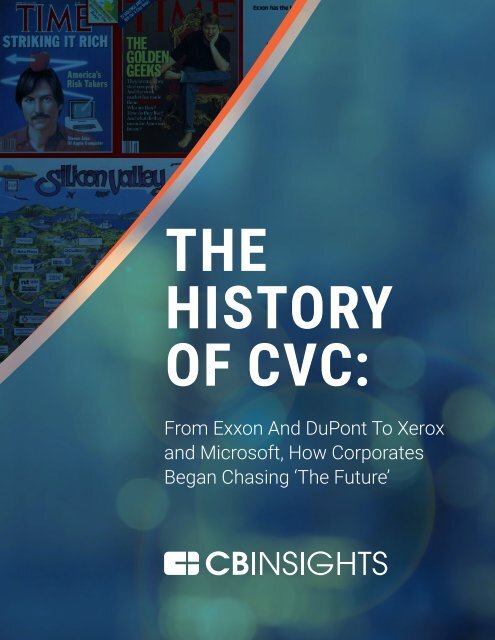THE HISTORY OF CVC
2nruRFS
2nruRFS
You also want an ePaper? Increase the reach of your titles
YUMPU automatically turns print PDFs into web optimized ePapers that Google loves.
<strong>THE</strong><br />
<strong>HISTORY</strong><br />
<strong>OF</strong> <strong>CVC</strong>:<br />
From Exxon And DuPont To Xerox<br />
and Microsoft, How Corporates<br />
Began Chasing ‘The Future’
Startups who<br />
take investments<br />
from corporations<br />
are “doing<br />
business with<br />
the devil,”<br />
Fred Wilson<br />
at the CB Insights Future<br />
of Fintech conference in<br />
June 2016<br />
“I think corporations<br />
should<br />
buy companies.<br />
Investing in<br />
companies<br />
makes no sense.<br />
Don’t waste your<br />
money being a<br />
minority investor<br />
in something<br />
you don’t control.<br />
You’re a corporation!<br />
You want the<br />
asset? Buy it.”<br />
Fred Wilson<br />
On June 8, 2016 hundreds of businesspeople<br />
filed into the Metropolitan<br />
Pavilion in New York’s Chelsea<br />
neighborhood for a conversation<br />
featuring Fred Wilson of Union Square<br />
Ventures. They probably didn’t expect a<br />
take-down of corporate venture capital<br />
at the Future of Fintech conference,<br />
since corporate investors weighed<br />
heavily on the attendee and panelist<br />
list. But that’s what they got.<br />
On stage, Wilson railed against<br />
corporations making bets on startups.<br />
“Corporate investing is dumb,” he said.<br />
“I think corporations should buy companies.<br />
Investing in companies makes no<br />
sense. Don’t waste your money being<br />
a minority investor in something you<br />
don’t control. You’re a corporation! You<br />
want the asset? Buy it.”<br />
Wilson’s comments cut against the<br />
grain. Corporate startup investing<br />
has actually grown steadily in recent<br />
years, with large companies from IBM<br />
to 7-Eleven investing in startups both<br />
directly and especially through dedicated<br />
venture capital arms. <strong>CVC</strong> units<br />
have become a relatively common feature<br />
of large corporate organizations,<br />
and companies seemingly far removed<br />
from tech and biotech are investing<br />
in startups, including Coca-Cola, Wal-<br />
Mart, and Campbell Soup Company.<br />
So why do Fortune 500 corporations<br />
start corporate venture units and invest<br />
in small, risky companies developing<br />
untested products and services? Is it<br />
realistic for them to imagine they can<br />
absorb innovative technologies and<br />
business models simply by taking a<br />
stake in a startup? Can they compete<br />
for deals against specialists like<br />
Wilson and other top VCs who may<br />
be better compensated?<br />
To answer these questions, it’s<br />
important to understand the history of<br />
corporate venture capital. Digging into<br />
the history, it’s clear that the tensions<br />
and contradictions surrounding <strong>CVC</strong><br />
have been there from the start: the<br />
tension between financial and strategic<br />
aims, the contradictory evidence over<br />
whether startup investing actually<br />
works as a form of “outsourced R&D,”<br />
and the difficulty in competing for the<br />
best deals.<br />
In this report, we dive into the history<br />
of corporate venture investing:<br />
• The Origins: GM and DuPont<br />
• First Wave: Conglomerate Venture<br />
Capital, 1960-1977<br />
• The Second Wave: Silicon Valley,<br />
1978-1994<br />
• The Third Wave: Irrational<br />
Exuberance? 1995-2001<br />
• Fourth Wave: The Unicorn Era,<br />
2002 to Present<br />
As <strong>CVC</strong>s increase in number and<br />
diversity, it will become increasingly<br />
important to understand their historical<br />
origins, motivations, and constraints.<br />
212 292 3148 info@cbinsights.com cbinsights.com
The number of<br />
active <strong>CVC</strong> units<br />
has doubled<br />
since 2012<br />
The Origins: GM and DuPont<br />
In some sense, corporate venture capital<br />
can be traced back to the earliest<br />
days of America’s business giants.<br />
It was 1914 when Pierre S. du Pont,<br />
president of chemical and plastics<br />
manufacturer DuPont, invested in a<br />
still private 6-year-old automobile<br />
startup named General Motors. Pierre<br />
du Pont had picked a winner. Like<br />
shares in a present-day Silicon Valley<br />
success, the stock leapt in value seven-fold<br />
over the course of World War<br />
I as wartime needs led to increased<br />
demand for automobiles.<br />
After the war, the companies would<br />
become even more intertwined.<br />
DuPont’s board of directors invested<br />
$25M in GM, betting the cash injection<br />
could speed GM’s development, which<br />
in turn would also expand the demand<br />
for DuPont’s own goods — including<br />
artificial leather, plastics, and paints.<br />
Not to mention, they saw GM as a<br />
promising investment. The company,<br />
which had gone public in 1916, was<br />
growing sales 56% annually, already<br />
had over 85,000 employees, and had<br />
begun building a new Detroit headquarters<br />
for its executives.<br />
In other words, DuPont’s bet on GM<br />
blended strategic and financial aims,<br />
a mixed strategy that would also later<br />
come to define more formal corporate<br />
venture capital units.<br />
DuPont, along with companies like 3M<br />
and Alcoa, would go on to pioneer the<br />
first major era of corporate venture<br />
investing. DuPont, in fact, developed<br />
the largest corporate venture program.<br />
This first flowering of <strong>CVC</strong> stretched<br />
from the late fifties and early sixties,<br />
roughly, until the stagflation crises of<br />
the seventies.<br />
212 292 3148 info@cbinsights.com cbinsights.com
GM headquarters,<br />
Detroit<br />
First Wave: Conglomerate<br />
Venture Capital, 1960-1977<br />
The prevailing spirit of American big<br />
business at mid-century favored large<br />
diversified corporations operating in<br />
many sectors. The head of General<br />
Motors, which then employed<br />
hundreds of thousands of employees,<br />
could plausibly say that what was good<br />
for GM was good for the country.<br />
The push for diversification was, in part,<br />
a result of strict anti-trust enforcement<br />
following the Great Depression, which<br />
prevented companies from exerting<br />
too much control in any of their<br />
established markets and forced them<br />
to look to new opportunities in order<br />
to increase profits. For companies<br />
looking to expand, corporate venture<br />
investing became a natural way to<br />
extend a company’s reach into a variety<br />
of different sectors and industries.<br />
Early <strong>CVC</strong> investors had<br />
three primary motivations:<br />
1 Fast growing companies wanted to<br />
diversify and find new markets.<br />
2 American industrial conglomerates,<br />
at the height of their success, were<br />
flush with cash and wanted to put it<br />
to productive use.<br />
3 Venture capital was experiencing<br />
its first successes with the nascent<br />
tech industry, providing a model for<br />
corporations to follow.<br />
<strong>CVC</strong> investors during this early period<br />
included many titans of American<br />
industry: Dupont, 3M, Alcoa, Boeing,<br />
Dow, Ford, GE, General Dynamics,<br />
Mobil, Monsanto, Ralston Purina,<br />
Singer, WR Grace, and Union Carbide.<br />
Not many of these companies are<br />
the sort of brands we would<br />
traditionally associate with venture<br />
capital (although amidst the current<br />
resurgence of <strong>CVC</strong> programs, many of<br />
these companies that have survived<br />
do in fact have <strong>CVC</strong> programs today).<br />
Earlier in the 20th Century, venture<br />
capital was not always exclusively<br />
tied to the tech or pharma industries.<br />
Indeed, there was not much of a<br />
tech industry to speak of during<br />
this period — computers still took up<br />
entire rooms and had not yet<br />
emerged from elite corridors into<br />
popular consciousness.<br />
Early <strong>CVC</strong> investors employed a variety<br />
of <strong>CVC</strong> models, often at the same<br />
time. Companies invested in internal<br />
212 292 3148 info@cbinsights.com cbinsights.com
employee ventures, and tried to spin<br />
out languishing in-house technologies<br />
into new ventures. In addition,<br />
corporations also invested in external<br />
startups, usually firms that addressed<br />
the parent corporation’s needs or strategic<br />
objectives, as was the case with<br />
DuPont and 3M. The most successful<br />
of these early <strong>CVC</strong> programs was run<br />
by 3M, whose internal <strong>CVC</strong> program<br />
famously produced Post-it notes, a<br />
classic business school case study.<br />
But there were also examples of<br />
companies that stretched further<br />
with their venture arms, looking far<br />
beyond their core businesses and<br />
embracing new technology as the<br />
key means of diversifying. While this<br />
may have been prescient, it was not<br />
necessarily prudent.<br />
‘Very bright and very careful’:<br />
Exxon Enterprises in the<br />
first wave<br />
An emblematic program of the first<br />
<strong>CVC</strong> era was Exxon Enterprises. Exxon<br />
was probably the largest <strong>CVC</strong> investor<br />
of the 1970s, overtaking DuPont,<br />
which is thought to have had the<br />
largest program in the 1960s.<br />
The group was founded in 1964 with<br />
the intention of exploiting underutilized<br />
technologies from Exxon’s<br />
corporate labs. The group then later<br />
began to make minority investments<br />
in external startups and finally pivoted<br />
one final time to focus on computing<br />
systems for commercial use.<br />
Behind Exxon’s push to diversify<br />
beyond the oil business were the<br />
1970s energy crises, which began in<br />
1973. With Middle Eastern countries<br />
and OPEC suddenly seemingly willing<br />
to choke off the largest sources of oil,<br />
the prognosis for the industry became<br />
much more uncertain.<br />
The president of Exxon Enterprises said<br />
in 1976 that the goal of the program<br />
was “to involve the corporation in new<br />
technologies and in new business<br />
opportunities that could have some<br />
significance in the 1980s and beyond.”<br />
Exxon Enterprises invested in 37<br />
ventures during the 1970s¹, about half<br />
internal and half external; companies<br />
with names like Qume, Vydec, Ramtek,<br />
Qwip, and Xentex.<br />
These companies made products far<br />
outside of Exxon’s core business: a<br />
test scoring machine, a high-speed<br />
printer, air pollution mitigation technology,<br />
a text-editing machine, surgery<br />
equipment, solar heating panels,<br />
graphite composite golf club shafts,<br />
and advanced computers (a partial list<br />
can be found via The New York Times).<br />
Exxon Enterprises also had two<br />
wholly owned subsidiaries, a company<br />
that manufactured and sold gasoline<br />
pumps and other service–station<br />
equipment and Exxon Nuclear,<br />
a commercial supplier of nuclear<br />
fuel products.<br />
A company spokesperson told the New<br />
York Times in 1976 that small venture<br />
investments were one of the only ways<br />
the company could diversify while<br />
avoiding anti-trust litigation. The company,<br />
itself the product of a landmark<br />
antitrust suit, did, indeed, have a major<br />
acquisition blocked by the government<br />
a few years later.<br />
Although the idea of Exxon investing<br />
in graphite composite golf club shafts<br />
may have seemed strange to some<br />
observers at the time, the company<br />
was generally praised for its efforts.<br />
An anonymous venture capitalist<br />
described Exxon Enterprises’ staff to<br />
The New York Times as “very bright<br />
and very careful.” And a writer at the<br />
Harvard Business Review argued in<br />
1980 that corporate venture investing<br />
has “allowed Exxon to transform<br />
itself from a huge —though unglamorous<br />
— one-product, narrow-technology<br />
oil company” — that was already<br />
pulling in $49B per year in revenue at<br />
the time — “to an exciting company<br />
that is expanding into computers<br />
and communications, advanced<br />
composite materials, and alternative<br />
energy devices.”<br />
Another VC investor speculated in<br />
1976 that “someday you might be<br />
able to drive into the local Exxon<br />
station for gas and while you’re there,<br />
rent a telephone, a computer or almost<br />
anything else you want.”<br />
As the years dragged on, Exxon grew<br />
impatient with its investments and<br />
tried to merge and consolidate these<br />
ventures under Exxon’s corporate<br />
structure, but the entrepreneurs, who<br />
had been promised relative freedom<br />
to pursue their projects as they saw fit,<br />
fled and the efforts collapsed, leading<br />
to tens of millions of dollars in losses.<br />
Exxon Enterprises then regrouped<br />
and refocused, putting its emphasis<br />
on organizing its companies to sell<br />
computing systems and aspiring to<br />
become the next IBM or Apple. In<br />
fact, the company actually released<br />
a personal computer in 1982.<br />
In addition, as part of this effort, it<br />
invested in and helped nurture an<br />
innovative microprocessing company<br />
by an early Intel engineer. But Exxon’s<br />
push for consolidation of its companies<br />
to achieve vertical integration<br />
212 292 3148 info@cbinsights.com cbinsights.com
in the computing market undermined<br />
its position as it unwillingly<br />
became a competitor to the same<br />
computing companies who bought its<br />
microprocessors. When Exxon shut<br />
down the program in 1984, the losses<br />
on computing investments alone<br />
had surpassed $2B. Exxon had again<br />
decided to remain a “narrow-technology<br />
oil company.”<br />
The End Of The<br />
Diversification Era<br />
The first wave of corporate venture<br />
capital was largely finished by 1973,<br />
although some companies, as we<br />
have seen, continued to soldier on<br />
through the decade. The immediate<br />
cause of the decline was the economic<br />
downturn — the oil shocks and the<br />
stagflation crises — which led to the<br />
collapse of the IPO market and dried<br />
up the rich cash flows that had been<br />
funding much <strong>CVC</strong> activity.<br />
In addition, the seventies saw the<br />
“shareholders’ revolution” and companies<br />
pulled apart during the beginning<br />
of corporate raider era. There was also<br />
more lax anti-trust regulation. All this<br />
put an end to the frantic diversification<br />
pushing the first wave of <strong>CVC</strong>.<br />
The average <strong>CVC</strong> program of this<br />
first era lasted four years. Another,<br />
less-known reason for the decline in<br />
<strong>CVC</strong> was a substantial increase to the<br />
capital gains tax in 1969, which hurt<br />
stand-alone venture capital firms —<br />
which many corporations emulated.<br />
By 1978, only 20 US corporations had<br />
an active <strong>CVC</strong> program.² Around this<br />
time, however, regulatory, cultural, and<br />
technological changes took hold that<br />
would stimulate and spur the second<br />
wave of corporate venture capital<br />
activity into action.<br />
The Second Wave: Silicon<br />
Valley, 1978-1994<br />
The release of the first personal<br />
computers in the late 1970s was the<br />
signature event that would ultimately<br />
drive the second wave of corporate<br />
venture capital investment. While<br />
corporations in the first wave looked<br />
inward for innovation and invested<br />
externally to diversify their businesses,<br />
the second wave was marked by<br />
recognition of the epochal changes<br />
introduced by computers and a sense<br />
in the business community that they<br />
must engage or risk obsolescence.<br />
Technology was becoming a<br />
consumer-facing industry and Silicon<br />
Valley was becoming “Silicon Valley”<br />
in the popular imagination in the early<br />
1980s; Time Magazine named the<br />
computer as its machine of the year<br />
in 1983. The hype surrounding the PC’s<br />
rise set a pattern that would continue<br />
in subsequent periods of corporate<br />
venture capital activity: a new, “can’t<br />
miss” technology breaks through in<br />
the market, generates enthusiasm in<br />
the business community and broader<br />
culture, and ultimately helps stimulate<br />
investment activity.<br />
Early tech success stories like<br />
Microsoft and Apple were celebrated<br />
by the press, and their founders,<br />
Bill Gates and Steve Jobs, came to<br />
represent a new kind of businessmen<br />
in a culture still dominated by the staid<br />
image of the company man. Gates and<br />
Jobs were already near-celebrities, a<br />
whiff of counterculturalism about them.<br />
As a result, entrepreneurship became a<br />
buzzword for the first time.<br />
A contemporary article in The New<br />
York Times proclaimed, “A Pioneer<br />
Sweeps Business” and offered the<br />
following observations:<br />
Nearly 160 schools now offer<br />
courses in entrepreneurship — up<br />
from 16 in 1970. At Harvard — training<br />
ground for the new generation<br />
of business leaders — nearly<br />
two-thirds of all students take<br />
the entrepreneurial management<br />
course and, last year, 80% of firstyear<br />
Harvard students said they<br />
wanted to own and manage their<br />
own business someday.<br />
Some of the people are going into<br />
business not because they have<br />
a fundamental belief in American<br />
capitalism, but because they have<br />
a social mission.<br />
Young people by the droves —<br />
refugees from corporate life,<br />
career-minded housewives and<br />
the cream of the business school<br />
elite — are turning their backs<br />
on giant corporations and going<br />
it alone. In doing so, they have<br />
pushed forth America’s inventive<br />
edge and are restoring vitality to<br />
an economy that, far too often in<br />
recent years, seemed to have lost<br />
its competitive might.<br />
None of this would sound unusual<br />
in 2017 (or 1998) — but this article<br />
was written in 1984. Zenas Block, a<br />
professor of management at New<br />
York University, told The New York<br />
Times in 1985, “media publicity given<br />
to private entrepreneurship has been<br />
considerable, and that has had a major<br />
impact on large corporations.”<br />
212 292 3148 info@cbinsights.com cbinsights.com
Silicon Valley,<br />
1991<br />
Source: Reddit/Imgur<br />
via Business Insider<br />
<strong>CVC</strong>s are followers<br />
not leaders<br />
As is often the case in the history<br />
of <strong>CVC</strong>, corporate investors largely<br />
followed the lead of private venture<br />
capital, which was reinvigorated by<br />
favorable regulatory changes in the<br />
late seventies. Private VC received a<br />
big boost in 1978 when the capital<br />
gains tax was significantly reduced,<br />
and then again in 1980, when it was<br />
lowered once more, incentivizing<br />
investment and creating a boom in<br />
venture capital. This increased the<br />
pool of capital available to entrepreneurs,<br />
incentivizing entrepreneurship,<br />
and creating a positive feedback loop.<br />
Between 1977 and 1982, the amount<br />
of money dedicated to venture capital<br />
grew from $2.5B to $6.7B.<br />
Corporate funds accounted for a significant<br />
portion of this capital. Money<br />
from public corporations accounted<br />
for 41% of the $2.5B dedicated to the<br />
diminished venture capital industry<br />
in 1977, which includes both active<br />
corporate investors and passive investments<br />
by corporations in independent<br />
VC firms. By 1982, that figure had<br />
fallen to 27% of the $6.7B dedicated<br />
to venture capital, which nonetheless<br />
still represents an increase in overall<br />
corporate dollars.<br />
Companies employed several models<br />
in pursuing corporate venture capital<br />
programs during this period, often<br />
pursuing multiple strategies at once.<br />
• Some companies preferred an<br />
indirect approach. Many companies<br />
simply gave their money to<br />
independent VC firms. Around 100<br />
companies used this approach in<br />
1987; by 1989, $483M of corporate<br />
money was invested in independent<br />
VCs, 20% of the total.<br />
• Other times corporations provided<br />
the capital for a dedicated VC fund<br />
handled by an external fund manager,<br />
an indirect approach known as a<br />
client-based fund. Corporations<br />
sometimes teamed up to create a<br />
client-based fund; AT&T, 3M, and<br />
Gulf and Western, for example,<br />
came together to create Edelson<br />
Technology Partners, operated by<br />
a former Wall Street analyst. The<br />
number of client-based funds rose<br />
from 31 in 1982 to 102 in 1987.³<br />
• Internally managed <strong>CVC</strong> funds also<br />
grew in popularity over the decade,<br />
212 292 3148 info@cbinsights.com cbinsights.com
ising in number from 28 in 1982<br />
to 76 in 1988. Some corporations<br />
made direct VC-style investments<br />
outside of any dedicated <strong>CVC</strong> fund;<br />
corporates made 245 such deals in<br />
1985, up from 30 in 1980.<br />
• Others pursued more idiosyncratic<br />
strategies. Eastman Kodak, for<br />
example, used a significant percentage<br />
of its $80M <strong>CVC</strong> fund to finance<br />
internally developed employee<br />
ideas that fell outside of its core<br />
business.<br />
The motivations behind the second<br />
wave of corporate venture capital<br />
largely mirrored those of the first:<br />
companies wanted access to<br />
technology, sometimes as means for<br />
diversification or sometimes to expand<br />
into adjacent product lines, albeit in<br />
a more disciplined, less wide-ranging<br />
fashion than during the first wave of<br />
<strong>CVC</strong>, rationalizing that <strong>CVC</strong> was often<br />
cheaper and more profitable than<br />
outright acquisition.<br />
Access to technology could also<br />
mean protecting or hedging against<br />
existing technologies. When the tech<br />
industry was looking for alternatives to<br />
silicon-based chips, Analog Devices, a<br />
maker of silicon-based chips, started<br />
a <strong>CVC</strong> program to invest in competing<br />
technologies. No alternative was found<br />
and Analog Devices’ investments<br />
largely failed — but the company would<br />
have been well-positioned had an<br />
alternative emerged.<br />
Given some of these motivations, the<br />
parent corporate’s strategies were<br />
not always beneficial for the startups<br />
they invested in. General Motors, for<br />
example, invested in five machine<br />
vision companies in order to create<br />
technology that could automatically<br />
inspect parts on the assembly line.<br />
The company pushed these companies’<br />
product development strategy to meet<br />
GM’s needs until finally they decided to<br />
abandon the tech and cut spending on<br />
the products, effectively abandoning<br />
the companies.<br />
<strong>CVC</strong> expands it reach<br />
While the second wave of <strong>CVC</strong> was<br />
largely focused on the technology<br />
industry, this was not exclusively the<br />
case. Colgate, Raytheon, and GM, for<br />
example, had <strong>CVC</strong> programs. General<br />
Electric still had its <strong>CVC</strong> fund from the<br />
first wave and invested in a number<br />
of successful tech startups. Xerox,<br />
Johnson & Johnson, Dow, WR Grace,<br />
and Motorola likewise maintained <strong>CVC</strong><br />
programs from the first wave.<br />
There were also a number of robust<br />
<strong>CVC</strong> investors among metal and<br />
chemical companies, such as Dow<br />
and WR Grace. One of the most<br />
active <strong>CVC</strong> investors of the period<br />
was Lubrizol Corporation, a chemical<br />
company, which invested in, among<br />
other companies, Genentech, which<br />
was backed by Kleiner Perkins Caufield<br />
& Byers and was one of the giant exits<br />
of 1999, when it went public with a<br />
$10.8B valuation.<br />
In addition, the second wave of <strong>CVC</strong><br />
was when, for the first time, foreign<br />
companies, especially from Japan,<br />
instituted <strong>CVC</strong> programs as well,<br />
although the investment was still<br />
largely confined to the US. Japanese<br />
companies made 60 investments in<br />
US-based companies in 1989, and their<br />
share of US-based <strong>CVC</strong> programs rose<br />
to 12% from 3% in 1983.<br />
By 1990, there were 138 corporate<br />
investors in European VC funds,<br />
although only a few European<br />
corporates had internally managed<br />
<strong>CVC</strong> funds.4<br />
Mark Radtke of consulting firm Venture<br />
Enterprises told The New York Times<br />
in 1986 that foreign corporations<br />
viewed VC as “an easy way … to effect<br />
a technological transfer,” i.e. gain<br />
access to new American technology.<br />
There was also some investment<br />
flowing in the opposite direction.<br />
For example, Monsanto, DuPont,<br />
3M, IBM, and Apple teamed up to<br />
create a client-based fund focused<br />
on European investments.<br />
Hedging against the past:<br />
Xerox Technology Ventures<br />
One of the most prominent corporate<br />
investors of the second wave was<br />
Xerox, then one of the most cutting-edge<br />
companies in Silicon Valley,<br />
partly because of its famous Palo Alto<br />
Research Center (PARC).<br />
Xerox Parc, 2003<br />
Xerox had had an active <strong>CVC</strong> program<br />
since the 1960s, operating an internally<br />
managed fund that invested in some<br />
of the most legendary figures in Silicon<br />
Valley, including Raymond Kurzweil<br />
and Steve Jobs. Kurzweil got his start<br />
in technology when Xerox invested in<br />
his first company, Kurzweil Applied<br />
Intelligence Inc., in 1982, to develop a<br />
computer that could transcribe spoken<br />
English. The idea behind the investment<br />
was to create technology that<br />
would increase demand for Xerox’s<br />
printing products when it ultimately hit<br />
the market.<br />
When Apple released its revolutionary<br />
Macintosh computer, some observers<br />
claimed that it had commercialized<br />
technologies first developed at Xerox<br />
PARC, such as the mouse, windows,<br />
212 292 3148 info@cbinsights.com cbinsights.com
Meeting at Parc<br />
“The laser printer<br />
alone paid for all<br />
of the other PARC<br />
research projects<br />
many times over.<br />
If some of the<br />
innovation results<br />
fall off the wagon,<br />
so what?”<br />
Robert Adams<br />
and icons, even dating the origin of<br />
the supposed copying to a 1979 visit<br />
to the lab by Jobs and other Apple<br />
employees — the tour is considered<br />
a seminal event in Silicon Valley<br />
lore. Although the accusation that<br />
Apple outright copied its ideas for<br />
user interface from Xerox is generally<br />
refuted today, the revelations stung<br />
Xerox’s management. The company<br />
was eventually spurred into rethinking<br />
its <strong>CVC</strong> program in an effort to better<br />
capitalize on the company’s languishing<br />
in-house technologies.<br />
Xerox started Xerox Technology<br />
Ventures (“XTV”) in 1988 to exploit<br />
and monetize the technology created<br />
in PARC and its other research labs,<br />
funding it with $30M.<br />
The company’s chairman said at the<br />
time that it was “a hedge against<br />
repeated missteps of the past.” Apple<br />
was one of several examples in which<br />
technology initially developed by Xerox<br />
was commercialized by more nimble<br />
competitors.5 These “missteps” were<br />
prominently highlighted in a book<br />
released that same year, Fumbling<br />
the Future: How Xerox Invented, Then<br />
Ignored, the First Personal Computer.<br />
Not everyone thought the way Xerox<br />
had handled development at PARC was<br />
so terrible. Robert Adams, who would<br />
go on to lead XTV, argued, “The laser<br />
printer alone paid for all of the other<br />
PARC research projects many times<br />
over. If some of the innovation results<br />
fall off the wagon, so what?”<br />
XTV was modeled on the structure<br />
and practices of independent VC firms,<br />
one of the earliest examples of a<br />
quasi-independent <strong>CVC</strong> unit like what<br />
we see today: Managers were given<br />
flexibility to act quickly on investment<br />
decisions, were allowed to invest $2M<br />
without asking for permission, had<br />
autonomy to monitor, exit, and liquidate<br />
investments, and were charged to maximize<br />
ROI. And in keeping with a typical<br />
VC firm, there was a compensation<br />
scheme that recognized big winners<br />
drove results and thus rewarded<br />
greater risk taking.<br />
Between 1988 and 1996, XTV<br />
invested in more than a dozen companies<br />
created from Xerox’s existing<br />
technologies. The companies were<br />
staffed with outside employees and<br />
allowed to make their own technological<br />
decisions, and Xerox never intended<br />
to maintain control of the companies,<br />
and involved outside VCs as the<br />
companies grew.<br />
XTV was an enormous financial success,<br />
netting capital gains of $219M<br />
on the company’s initial investment, an<br />
astounding net internal rate of return<br />
of 56% — far larger than comparable<br />
returns by independent VCs during the<br />
same period.6<br />
Nonetheless, XTV was terminated<br />
early and replaced with Xerox New<br />
Enterprises, which did not relinquish<br />
212 292 3148 info@cbinsights.com cbinsights.com
control of firms or allow for outside<br />
investment, and likewise used a<br />
more standard corporate investment<br />
compensation scheme.<br />
Why was it scrapped despite the<br />
successes? XTV had created a lot of<br />
internal strife at Xerox, partly because<br />
of its compensation structure, which<br />
lavishly rewarded XTV’s executives,<br />
creating tension with other Xerox managers,<br />
a common problem for <strong>CVC</strong>s.<br />
In addition, some believed that XTV<br />
startups succeeded at the expense of<br />
other Xerox units while utilizing Xerox<br />
resources, which further undermined<br />
the VC unit.<br />
A brief hiatus<br />
The demise of XTV highlights the<br />
precarious position of even the most<br />
successful <strong>CVC</strong> programs, which can<br />
still fall victim to management’s whims<br />
or internal bickering between corporate<br />
units. The average lifespan of a <strong>CVC</strong><br />
program between 1988 and 1996 was<br />
2.5 years, one-third the duration of an<br />
independent VC.7<br />
The 1987 stock market crash is widely<br />
considered to have brought the second<br />
wave of corporate venture capital to<br />
an end. <strong>CVC</strong> direct investment peaked<br />
in 1986, with approximately $750M<br />
of <strong>CVC</strong> investment, up from $300M<br />
the year before.8 The total number of<br />
companies with some sort of <strong>CVC</strong><br />
program fell by a third between 1987<br />
and 1992. Likewise, indirect <strong>CVC</strong><br />
investment by investing in funds set<br />
up by independent VCs fell to $84M in<br />
1992, from $483M in 1989.9<br />
Nonetheless, some <strong>CVC</strong> indicators<br />
continued to rise after the crash.<br />
The number of internally managed<br />
<strong>CVC</strong> funds rose to 95 in 1991, from<br />
76 in 1988, before falling to 69 in<br />
1992, wiped out by the Savings &<br />
Loan recession.¹0<br />
If Time Magazine’s “Machine of the<br />
Year” presaged the second major <strong>CVC</strong><br />
wave, a different magazine cover more<br />
than a decade later augured the beginning<br />
of the third wave of corporate<br />
venture capital.<br />
The Third Wave: Irrational<br />
Exuberance? 1995-2001<br />
On August 9, 1995, Netscape<br />
Communications Inc. went public and<br />
its shares more than doubled on the<br />
first day — an unprecedented event for<br />
a company that had yet to earn a profit.<br />
Six months later, Netscape founder<br />
Marc Andreessen — barefoot, sitting<br />
on what appeared to be a throne —<br />
was featured on the cover of Time<br />
magazine next to the headline “The<br />
Golden Geeks.”<br />
The dot com boom had begun. If<br />
the personal computer was the<br />
breakthrough technology that drove<br />
the second wave of corporate venture<br />
capital, the internet was undoubtedly<br />
the impetus behind the third wave,<br />
which far outpaced its predecessors in<br />
scope and size.<br />
In 2000 alone, more than 20 new <strong>CVC</strong><br />
groups made their first investment,<br />
according to CB Insights data. Nearly<br />
100 <strong>CVC</strong>s made their first investments<br />
in the years between 1995 and 2001.<br />
Total dollars from deals involving <strong>CVC</strong>s<br />
grew to approximately $17B in 2000,<br />
or 25% of total funding to VC-backed<br />
companies in that year.<br />
<strong>CVC</strong> also continued to internationalize<br />
during this period, even as the US<br />
remained the most important market.<br />
Between 1990 and 1999, 71% of <strong>CVC</strong><br />
investors and 75% of <strong>CVC</strong> firms were<br />
located in the US; the real percentage<br />
of US-based firms may have been<br />
even smaller because some foreign<br />
corporations set up their <strong>CVC</strong> units in<br />
the US. 12 Large Japanese companies,<br />
for example, began the practice of<br />
sending executives on work rotations<br />
in the offices of private VC funds they<br />
had invested in to bring the gleaned<br />
information and experience back to<br />
headquarters. 13 American companies,<br />
conversely, began to use <strong>CVC</strong> as a<br />
means of accessing foreign markets or<br />
foreign technology.<br />
The alternative R&D era<br />
sweeps in<br />
Part of the reason for this enormous<br />
growth in <strong>CVC</strong> activity was, as always,<br />
hype building on hype. As Paul<br />
Gompers and Josh Lerner write in The<br />
Venture Capital Revolution, the publicity<br />
around early high-profile success<br />
stories like eBay and Yahoo “triggered<br />
the interest of many CEOs, who sought<br />
to harness some of the same energy<br />
in their organizations.” However, it also<br />
reflected real changes in the broader<br />
business environment.<br />
Companies that had previously relied<br />
on a central R&D lab were experimenting<br />
with new models to drive innovation,<br />
because, as we have already seen<br />
from prior waves, new technologies<br />
often languished internally or were<br />
commercialized by more agile competitors,<br />
often startups. Small firms’ share<br />
of total dollars spent on R&D in the US<br />
rose from 4.4% in 1981 to 24.4% in<br />
2009. At this point, startups are filing<br />
roughly 30% of patent applications. 14<br />
212 292 3148 info@cbinsights.com cbinsights.com
<strong>CVC</strong> was thus a natural way for companies<br />
to access alternative R&D, allowing<br />
them to outsource at least part of their<br />
research and development to smaller,<br />
nimbler startups. Pharmaceutical<br />
companies and freshly ascendant tech<br />
mega-companies emerged as major<br />
<strong>CVC</strong> investors during this period.<br />
However, whereas <strong>CVC</strong> investors were<br />
historically companies with a research<br />
and development DNA, the profile of<br />
<strong>CVC</strong> participants began to change<br />
with the enormous expansion of <strong>CVC</strong><br />
investment. Media and advertising<br />
companies, for example, rushed into<br />
<strong>CVC</strong> for the first time. Reuters, News<br />
Corp., Reed Elsevier, and the WPP<br />
Group, among others, started <strong>CVC</strong><br />
programs. The production company<br />
behind “The Blair Witch Project” even<br />
started a <strong>CVC</strong> fund with $50M<br />
of investment capital. (They<br />
successfully completed at least<br />
one investment but the production<br />
company shut down in 2003.)<br />
The scale of companies’ individual <strong>CVC</strong><br />
programs far outstripped anything that<br />
had come before. In September 2000,<br />
for example, the German media conglomerate<br />
Bertelsmann AG pledged<br />
$1B to a fund investing in new media<br />
startups — which, even if it was only<br />
a pledged figure, exceeded the size of<br />
total <strong>CVC</strong> investment at the height of<br />
the second wave.<br />
The growth of <strong>CVC</strong> also accentuated<br />
some of its internal contradictions,<br />
notably around issues of compensation.<br />
Independent VCs were<br />
minting fortunes during the tech boom,<br />
seemingly overnight, far exceeding<br />
anything that had occurred prior. Many<br />
<strong>CVC</strong> programs, however, did not offer<br />
compensation structures like those<br />
of traditional VCs. <strong>CVC</strong>s couldn’t<br />
justify the enormous payouts to<br />
individual senior investors associated<br />
with successful VC investment and<br />
as a result companies would often<br />
train or develop <strong>CVC</strong> investors, only<br />
to see them jump to independent<br />
competitors in search of more lucrative<br />
compensation. GE Equity, for example,<br />
lost a total of 18 investors between<br />
1998 and 1999, many of whom went to<br />
leading VC firms.<br />
Despite this tension, this period saw<br />
closer collaboration between corporate<br />
and private venture capital investors<br />
than in any of the previous waves. This<br />
occurred because the VC market was<br />
overcrowded, and partnerships with<br />
corporations offered independent VCs<br />
a competitive advantage, according to<br />
Gompers and Lerner.<br />
These partnerships often went beyond<br />
investment syndicates. Kleiner<br />
Perkins, for example, set up a Java<br />
Fund as a way for companies to<br />
stimulate demand for the technology<br />
by investing in companies creating<br />
Java-based applications, which held<br />
the promise of being compatible<br />
with multiple operating systems.<br />
Investors in the fund included<br />
Cisco Systems, Compaq Computer,<br />
IBM, Netscape Communications,<br />
Oracle, Sun Microsystems, and<br />
Tele-Communications Inc. These<br />
companies wanted to legitimize the<br />
language, which had the potential<br />
to break Microsoft’s chokehold on<br />
application development.<br />
Others sought to benefit from the<br />
advantages of bringing private and<br />
corporate venture capital together.<br />
Texas Instruments, for example,<br />
partnered with independent VC Granite<br />
Ventures to create a fund, TI Ventures.<br />
The fund was directed to invest in<br />
strategic companies for TI, but within<br />
that, Granite focused on maximizing<br />
financial returns.<br />
Approaches to <strong>CVC</strong> also began to<br />
change during this period. <strong>CVC</strong> was<br />
once about entering new markets or<br />
expanding product lines, but this new<br />
third wave of <strong>CVC</strong> focused on defending<br />
and supporting existing product<br />
lines by fostering a healthy business<br />
environment and ecosystem around<br />
those products. No company better<br />
exemplifies this strategy than Intel<br />
Capital, arguably the most successful<br />
longstanding <strong>CVC</strong> program.<br />
Intel Capital: Steady does it<br />
Intel Capital was founded in 1991 as<br />
a way to centralize Intel’s external<br />
investments, which had previously<br />
been handled by each individual<br />
business unit. While the venture unit<br />
initially focused on filling in gaps in<br />
its product line and rounding out its<br />
technology, it broadened its mandate<br />
in the mid-1990s to invest in the wider<br />
ecosystem surrounding Intel’s product<br />
offerings with the goal of improving<br />
market conditions. Intel Capital would<br />
be investing in “companies building<br />
technologies that supported, were<br />
sold alongside, or improved the value<br />
of Intel’s products in the marketplace,”<br />
according to a Harvard Business<br />
Review case study. This also included<br />
companies that stimulated demand for<br />
Intel’s products in the market.<br />
Intel’s strategy was often to invest in<br />
multiple startups competing in the<br />
same market, which irritated some<br />
independent VCs who typically don’t<br />
invest in competing companies.<br />
But Intel was more committed to<br />
stimulating emerging technologies and<br />
market sectors rather than the success<br />
of any individual company. While<br />
this could, in theory, be off-putting to<br />
entrepreneurs, many were nonetheless<br />
eager to access Intel’s extensive<br />
resources and technical expertise.<br />
Among the companies backed by Intel<br />
Capital were Broadcom, Clearwire, and<br />
Research in Motion.<br />
In 1999, for example, Intel started the<br />
Itanium 64 Fund, a $250M fund that<br />
invested in companies creating products<br />
using its Itanium 64-bit processor.<br />
Intel took a similar strategy in October<br />
2002 when it wanted to encourage<br />
the adoption of wireless technologies<br />
using the 802.11 network standards,<br />
unveiling a $150M fund to invest in<br />
companies developing products that<br />
would boost the adoption of Wi-Fi<br />
networks, which would boost the sales<br />
of its new Centrino chip sets.<br />
212 292 3148 info@cbinsights.com cbinsights.com
Itanium processor chip,<br />
produced 2001-2002<br />
Part of Intel’s success is also<br />
attributable to the fact that it focused<br />
on long-term goals, insulating itself<br />
from the boom-bust cycle that hurts so<br />
many <strong>CVC</strong> investors. Intel Capital was<br />
founded at a time when most other VC<br />
investors, independent and corporate,<br />
were pulling back.<br />
And in 2001, when <strong>CVC</strong> programs were<br />
shutting down in droves, Intel continued<br />
to play the market, investing more<br />
than industry stalwarts Kleiner Perkins<br />
and General Atlantic Partners. “It’s not<br />
an option not to do it,” Leslie L. Vadasz,<br />
the president of Intel Capital, said at<br />
the time. He later told researchers for<br />
the Harvard Business Review, “There<br />
is no question that corporate venture<br />
investing increases the risk of P&L<br />
volatility, but it is one of the risks you<br />
accept along with all the gains.”<br />
It certainly didn’t hurt Vadasz’s<br />
standing and ability gain the trust of his<br />
peers at Intel that he was Intel’s fourth<br />
employee and had previously run every<br />
major business unit at the company.<br />
At the height of the boom in 2000,<br />
Intel Capital posted gains of $3.7B,<br />
accounting for one third of Intel’s total<br />
profit. However, it then experienced<br />
10 successive quarters of losses that<br />
nearly wiped out those gains — but<br />
kept on investing throughout, and was<br />
again posting profitable quarters by<br />
early 2004.<br />
Despite its financial success, Intel’s<br />
investments have always been based<br />
on strategic value, never solely on<br />
potential returns. Also notable is<br />
that Intel’s investment program was<br />
more robust than most other <strong>CVC</strong>s:<br />
Between its founding in 1991 and<br />
2005, it had invested over $5B in<br />
more than 1000 companies — a<br />
rate of investment which surpasses<br />
most independent VCs. It also had a<br />
more international focus than other<br />
<strong>CVC</strong>s, investing more than 40% of<br />
its funds internationally. This often<br />
meant investing in companies that<br />
were improving internet access in<br />
international markets in the hope that<br />
it would increase PC sales and thereby<br />
demand for Intel’s products. A smaller<br />
portion of Intel Capital’s funds, about<br />
10%, was devoted to poking around the<br />
marketplace for potential threats and<br />
opportunities years down the line.<br />
Intel overcame the compensation issue<br />
internally by putting senior employees<br />
who were already deeply invested in<br />
the company in charge at Intel Capital.<br />
These individuals also had the institutional<br />
knowledge necessary to align<br />
Intel’s investments with the company’s<br />
overarching strategy. While Intel Capital<br />
did not take board seats, its observers<br />
did play an active role in shaping<br />
portfolio companies’ strategies and<br />
success in the market — in a way that<br />
stimulated synergies with Intel’s products<br />
and strategies — and provided<br />
portfolio companies with significant<br />
resources, including direct access to<br />
Intel’s executives. It also, crucially, had<br />
the support of management. As mentioned,<br />
Intel Capital’s president, Leslie<br />
L. Vadasz, was one of the company’s<br />
original employees.<br />
All of this meant that Intel was uniquely<br />
well-positioned when the inevitable<br />
downturn arrived.<br />
The tech bubble busts <strong>CVC</strong><br />
The third wave finally ended with<br />
massive declines in the stock market.<br />
Between March and May of 2000, the<br />
Nasdaq fell 40%. It clawed back about<br />
half of that loss by September, before<br />
losing another 50% through April of<br />
the following year. Many public tech<br />
companies went bust, as well as<br />
many tech startups that depended on<br />
a robust financing and IPO market to<br />
finance their expansion.<br />
Because most <strong>CVC</strong> units are funded<br />
through the balance sheet, <strong>CVC</strong><br />
investors are often required to use<br />
mark-to-market accounting, and as<br />
a result had to write down enormous<br />
losses during this period. While this<br />
method of accounting does not<br />
necessarily reflect real gains or losses,<br />
it can produce jaw-dropping headlines<br />
that nonetheless scare off executives<br />
and shareholders.<br />
Corporations were forced to write<br />
down $9.5B of venture related losses<br />
in the second quarter of 2001 alone.<br />
Microsoft wrote off more than $5.7B<br />
in 2001; Wells Fargo wrote down<br />
$1.2B; even Intel, previously impregnable,<br />
wrote down $632M. Numerous<br />
companies, including Microsoft, AT&T,<br />
and News Corp, shuttered their <strong>CVC</strong><br />
units; Amazon and Starbucks, among<br />
others, decided to no longer invest<br />
in startups; others liquidated their<br />
holdings in fire sales. As a result of<br />
the losses and write-downs, some<br />
companies faced pressure from large<br />
shareholders and activist investors<br />
who questioned the propriety and<br />
wisdom of <strong>CVC</strong> programs.<br />
212 292 3148 info@cbinsights.com cbinsights.com
Many companies unceremoniously<br />
dropped their <strong>CVC</strong> programs or ignored<br />
their investments, leaving a negative<br />
impression of corporate VC investors<br />
that persist, as we’ll see, in some<br />
circles today. Hewlett-Packard’s <strong>CVC</strong><br />
program, for example, invested in hundreds<br />
of startups. After the bust, the<br />
company largely ignored the program.<br />
By 2008, when it was finally winding<br />
down, no one at the company even<br />
knew if its portfolio companies were<br />
still in business, or had gone bust, or if<br />
they were earning the company strong<br />
returns — a team from the strategy<br />
and corporate development had to call<br />
around and find out. 15<br />
However, not all companies pulled out<br />
of the market. Biotech and pharmaceutical<br />
companies, in particular, retained<br />
robust <strong>CVC</strong> programs throughout<br />
the early part of the decade. Shell,<br />
Mitsubishi, and Johnson Matthey, for<br />
example, came together to form a <strong>CVC</strong><br />
fund investing in fuel cell technologies<br />
as late as 2002.<br />
Even if <strong>CVC</strong> was momentarily<br />
discredited in the eyes of many, the<br />
boom in <strong>CVC</strong> investing had given<br />
observers a broader set of data than<br />
ever before to provide insights about<br />
the phenomenon, to understand its<br />
successes and failures.<br />
Some of the data was encouraging.<br />
Paul Gompers writes in The Venture<br />
Capital Cycle that between 1982 and<br />
1994, firms backed by <strong>CVC</strong> were more<br />
likely to go public than those that were<br />
not. However, <strong>CVC</strong> investments did<br />
not, in general, outperform those of<br />
independent VCs, unless there was<br />
a strategic tie between the investing<br />
corporation and the startup.<br />
On the other hand, <strong>CVC</strong>s also paid<br />
significantly more for their investments.<br />
<strong>CVC</strong>s invested at an average valuation<br />
of $28.5M versus $18.2M for independent<br />
VCs. 16<br />
<strong>CVC</strong>s also invested less frequently over<br />
a more abbreviated period of time. The<br />
average <strong>CVC</strong> made 1.76 investments<br />
every year , whereas an independent<br />
VC made 5.75. 17<br />
What doomed many <strong>CVC</strong> programs<br />
of the period, most researchers agree,<br />
was a lack of strategic focus and<br />
clearly defined objectives. Many companies<br />
started <strong>CVC</strong> programs because<br />
it seemed, at the time, that any serious<br />
company had a <strong>CVC</strong> program, and<br />
everyone was doing it, not because<br />
they carefully thought through how<br />
such a program could improve their<br />
business — a problem compounded<br />
when outside investors were brought in<br />
to run the program.<br />
Companies wanted access to Silicon<br />
Valley without really knowing how<br />
Silicon Valley could be of service to<br />
them. They just knew it represented<br />
“The Future.” In other words, they<br />
were engaged in what CB Insights<br />
has dubbed “Innovation Theater.”<br />
Even if these programs had strategic<br />
objectives, the frothy atmosphere of<br />
speculation often meant that financial<br />
returns clouded out their original focus.<br />
As a result, they were swept away<br />
by the moment and over-invested in<br />
flashy startups with unclear benefits<br />
to the parent company’s core business.<br />
Then they were caught off-guard when<br />
everything went bust.<br />
Even if <strong>CVC</strong> garnered a bad reputation<br />
in some corners, though, there were<br />
still enough successes to convincingly<br />
demonstrate its importance and vitality<br />
in the right hands. It was always clear<br />
that <strong>CVC</strong> investing would one day<br />
make a comeback with the improved<br />
fortunes of the tech industry — but<br />
would it return again only to get caught<br />
up in the hype?<br />
212 292 3148 info@cbinsights.com cbinsights.com
Dollars are for<br />
deals involving<br />
<strong>CVC</strong>s, which<br />
often involve non-<br />
<strong>CVC</strong> investors as<br />
well<br />
Fourth Wave: The Unicorn<br />
Era, 2002 to Present<br />
While corporate venture capital fell off<br />
substantially after the bubble burst,<br />
it by no means disappeared. <strong>CVC</strong> as<br />
a percentage of total VC was halved,<br />
but <strong>CVC</strong> investment leveled out at<br />
about $2B per year through the first<br />
half of the decade, then began to<br />
increase again before dipping, along<br />
with the rest of VC investment, during<br />
the worst years of the global financial<br />
crisis — dollars from <strong>CVC</strong>-backed deals<br />
reached only $5.1B in 2009 — then took<br />
off when Silicon Valley began to<br />
boom again in the first half of the<br />
current decade.<br />
In 2012, for example, total funding<br />
from deals involving <strong>CVC</strong>s was<br />
$8.4B, according to CB Insights — a<br />
significant increase from 2009, but still<br />
less than half of total <strong>CVC</strong> investment<br />
during the boom years. It remained<br />
at roughly that level in the following<br />
year before doubling in 2014, and then<br />
jumping nearly 70% in 2015 to an<br />
unprecedented $28.4B.<br />
212 292 3148 info@cbinsights.com cbinsights.com
Dollars are for<br />
deals involving<br />
<strong>CVC</strong>s, which<br />
often involve<br />
non-<strong>CVC</strong> investors<br />
as well<br />
“If you’ve got<br />
the chops to be<br />
a real VC, you’re<br />
either moving<br />
up or moving<br />
down...at many<br />
companies it’s a<br />
revolving door of<br />
talent<br />
and climbers.”<br />
Sarah Lacy<br />
This trend reflects the broader increase<br />
in venture capital investment, which<br />
has more than doubled since 2011 and<br />
saw significant gains between 2013<br />
and 2014 and 2014 and 2015. At this<br />
point, though, <strong>CVC</strong> is actually growing<br />
at a faster rate than venture capital<br />
investment in general. But it only<br />
captures part of the picture: corporate<br />
financings of private companies, done<br />
outside of a <strong>CVC</strong> unit, have also seen<br />
substantial increases in recent years.<br />
With the new rise of <strong>CVC</strong>, critics have<br />
again surfaced. Sarah Lacy, editor of<br />
Pando, had a negative outlook, “At<br />
best, corporate VCs are a bit like minor<br />
league baseball teams. If you’ve got<br />
212 292 3148 info@cbinsights.com cbinsights.com
the chops to be a real VC, you’re either<br />
moving up or moving down. Either<br />
way, at many companies it’s a revolving<br />
door of talent and climbers.” (Fred<br />
Wilson, as we previously saw, also<br />
has his criticisms.)<br />
The obvious impetus for <strong>CVC</strong>’s resurgence<br />
was the dual rise of social media<br />
and the smartphone, most prominently<br />
represented by Facebook and the<br />
iPhone. Together, internet and mobile<br />
accounted for 63% of <strong>CVC</strong> dollars by<br />
the final quarter of 2016. Healthcare<br />
now also regularly tops software and<br />
hardware, both tech boom darlings, as<br />
a destination for <strong>CVC</strong> dollars. Another<br />
factor encouraging <strong>CVC</strong> activity is that<br />
corporations are sitting on historically<br />
large piles of cash and global interest<br />
rates are historically low.<br />
With the benefit of hindsight, two<br />
other events may have played a small<br />
role in nudging companies back into<br />
corporate venture capital. The first<br />
was Microsoft’s 2007 investment in<br />
Facebook, which was widely ridiculed<br />
at the time — ”Microsoft has to be<br />
seriously desperate to be considering<br />
this much of an investment for so<br />
little, even with its bags of cash to<br />
spend,” wrote Kara Swisher on the<br />
eve of the deal.<br />
Microsoft paid $240M for a 1.6%<br />
share of Facebook at a valuation of<br />
$15B. The company is valued at more<br />
than $300B today and the investment<br />
connected the by-then tech stalwart<br />
with the hottest startup in the world<br />
in the process.<br />
The second spark that helped <strong>CVC</strong>’s<br />
resurgence was Google’s 2008 decision<br />
to start Google Ventures, likewise<br />
derided by some. The outfit has since<br />
grown into one of the largest and most<br />
respected <strong>CVC</strong> investors — a strong<br />
endorsement of the idea from one<br />
of the world’s most successful and<br />
innovative companies.<br />
Nonetheless, hype and exuberance<br />
have undoubtedly contributed to the<br />
enormous growth in <strong>CVC</strong> in the past<br />
few years, buoyed by the triumphant<br />
press surrounding new technologies,<br />
a rash of new buzzwords, and the<br />
omnipresent fear of disruption. Arvind<br />
Sodhani, who led Intel Capital for ten<br />
years, told The New York Times earlier<br />
this year, “CEOs who are worried<br />
they’re going to get disrupted want to<br />
have an outpost in Silicon Valley<br />
to discern where the disruption is<br />
coming from.”<br />
The recent expansion of <strong>CVC</strong><br />
investment is impressive. There are<br />
now, as we saw, roughly 200 <strong>CVC</strong> units<br />
active in any given quarter, a number<br />
that is more than 2x what it was just<br />
five years ago. Some companies that<br />
ditched their <strong>CVC</strong> units after the bubble<br />
burst have decided to give it another<br />
go. Dell closed its <strong>CVC</strong> unit in 2004<br />
and reopened a new <strong>CVC</strong> unit in 2011.<br />
Microsoft, likewise, is revamping its<br />
<strong>CVC</strong> efforts.<br />
212 292 3148 info@cbinsights.com cbinsights.com
Microsoft Ventures:<br />
Disciplined ambition<br />
While Microsoft had an ad hoc corporate<br />
venture capital program in the<br />
1990s, making minority investments<br />
in startups without a formalized <strong>CVC</strong><br />
program, the new Microsoft Ventures<br />
unit represents an example of a mature<br />
model for corporate VC, pioneered by<br />
large technology companies and since<br />
adopted beyond the industry. Large<br />
write downs and losses following the<br />
tech bust, mentioned above, largely<br />
curtailed Microsoft’s ad hoc approach,<br />
although Microsoft did continue to<br />
make intermittent investments in<br />
startups, such as its 2007 investment<br />
in Facebook. At the beginning of 2016,<br />
however, Microsoft decided it was time<br />
to ramp up their investing activities<br />
and founded their first structured <strong>CVC</strong><br />
program, Microsoft Ventures.<br />
Nagraj Kashyap, formerly the head of<br />
Qualcomm Ventures, was brought on<br />
to spearhead the effort, and he has hit<br />
the ground running. In 2016, Microsoft<br />
Ventures invested in 18 companies, far<br />
more than Kashyap initially expected<br />
when he took on the job. The selection<br />
of Kashyap, who has been working in<br />
<strong>CVC</strong> for more than a decade, signified<br />
Microsoft’s intentions for the group.<br />
Kashyap came from Qualcomm<br />
Ventures, which like Intel Capital, emulates<br />
many independent VC firms and<br />
is focused on maximizing its financial<br />
returns. Kashyap confirmed that he<br />
would bring a similar philosophy to<br />
Microsoft, “We don’t see the distinction<br />
between financial and strategic [goals].<br />
The best financial companies make for<br />
the best strategic returns.”<br />
That does not mean, of course, that<br />
Microsoft Ventures will be investing in<br />
coffee startups or lifestyle brands. On<br />
the contrary, it is focused on enterprise<br />
startups providing business-to-business<br />
services, such as companies<br />
building next-generation cloud<br />
infrastructure, companies that help<br />
enterprises migrate to the cloud, and<br />
all sorts of business-oriented SaaS;<br />
thus far, enterprise startups account<br />
for approximately 90% of Microsoft<br />
Ventures’ investments.<br />
Why these companies? The answer<br />
is simple: These are the companies<br />
where Microsoft can provide the most<br />
help and technical support post-investment.<br />
Microsoft’s investment<br />
philosophy does not mean the venture<br />
arm is indifferent to strategic concerns,<br />
but rather that they have set investment<br />
parameters that fit their strategic<br />
interests and then focus on financial<br />
returns within those parameters. “If I<br />
spend an enormous amount of time<br />
engaging a company with Microsoft<br />
and it fails,” said Kashyap, “that is<br />
basically a waste of time for everybody.”<br />
Microsoft Ventures’ portfolio companies<br />
are under no obligation to work<br />
with Microsoft post-investment and<br />
vice-versa, and many of the startups<br />
have not even met with the company<br />
at the time of investment (excluding<br />
the investment team, of course).<br />
Nonetheless, the <strong>CVC</strong> offers these<br />
companies three services, should they<br />
accept an investment:<br />
• Technical integration with one of<br />
Microsoft’s products, such as Azure<br />
or Office 365, if it is beneficial to the<br />
portfolio company’s product<br />
• Go-to-market help, using<br />
Microsoft’s large and robust<br />
enterprise sales team<br />
• Promotional services, such as<br />
featuring a portfolio company at<br />
a Microsoft-held conference<br />
Microsoft Ventures makes the necessary<br />
introduction and then an internal<br />
business development team, staffed<br />
by Microsoft employees, manages<br />
its portfolio companies’ interactions<br />
with Microsoft.<br />
The investment team, however, is<br />
staffed by investment professionals,<br />
some of whom previously worked<br />
at other <strong>CVC</strong>s, like Intel Capital, or<br />
for independent VC firms, and they<br />
are expected to evaluate startups<br />
as any other VC would, without<br />
regard to a startup’s potential<br />
strategic advantages.<br />
Microsoft Ventures has no set<br />
investment budget, no limiting fund<br />
size, and no minimum or maximum<br />
required investments per year. In some<br />
regards, this means its investors have<br />
an even greater level of flexibility than<br />
their counterparts at independent VCs,<br />
highlighting a potential advantage of<br />
<strong>CVC</strong>. It has the autonomy to invest<br />
more or less in a company, take a large<br />
or small ownership stake, and invest<br />
in as many good opportunities as it<br />
can find.<br />
212 292 3148 info@cbinsights.com cbinsights.com
“As long as you’re<br />
making good<br />
investments, a<br />
corporate parent<br />
will typically not<br />
have problems<br />
with you spending<br />
more or less.”<br />
Nagraj Kashyap<br />
Kashyap sees the group’s focus on<br />
financial returns as key to maintaining<br />
its unusual degree of independence<br />
and flexibility, “As long as you’re making<br />
good investments, a corporate parent<br />
will typically not have problems with<br />
you spending more or less.”<br />
They have made good use of the<br />
flexibility thus far. Microsoft’s 18 deals<br />
in 2016 are more than many robust<br />
independent VCs typically make<br />
per year — and the group was only<br />
founded towards the end of January.<br />
Kashyap says that the market has<br />
gradually improved over the course of<br />
the year as valuations have become<br />
more rational than in recent years<br />
and entrepreneurs have accordingly<br />
lowered their expectations.<br />
As can be seen from the snapshot<br />
from CB Insights’ Investor Analytics<br />
tool above, Microsoft often invests<br />
after top VCs such as Bessemer<br />
and Data Collective, and also sees<br />
VCs and <strong>CVC</strong>s like Trinity Ventures,<br />
Intel Capital, and Accel invest in its<br />
portfolio companies.<br />
Kashyap believes that market conditions<br />
have fundamentally changed<br />
since the end of the last tech boom<br />
and there is unlikely to be a shakeout<br />
as brutal, despite concern over a<br />
unicorn-era bubble.<br />
Many <strong>CVC</strong> investors back then were<br />
looking for quick returns from portfolio<br />
companies’ IPOs — the criticism that<br />
they were short-term players was<br />
largely true, he says. Today, however,<br />
the IPO market is much less robust,<br />
meaning <strong>CVC</strong> investors can no longer<br />
expect an instant return on investment,<br />
and corporations’ balance sheets are<br />
generally much stronger — corporations<br />
are sitting on record levels of<br />
cash in a historically low interest rate<br />
environment — meaning that they can<br />
afford to focus on longer-term goals<br />
and let the companies they’ve invested<br />
in mature over time.<br />
212 292 3148 info@cbinsights.com cbinsights.com
“There’s always<br />
going to be<br />
immature actors<br />
— not bad actors<br />
but immature<br />
actors, because<br />
they [started<br />
investing] from<br />
the wrong perspective<br />
and for<br />
the wrong goals.”<br />
Nagraj Kashyap<br />
Critics aside, <strong>CVC</strong> grows up<br />
<strong>CVC</strong> investors have changed as well.<br />
There are enough established investors<br />
with strong track records that independent<br />
VCs and entrepreneurs are<br />
less wary of partnering with <strong>CVC</strong>s than<br />
they once were. Nonetheless, Kashyap<br />
warns, “There’s always going to be<br />
immature actors — not bad actors but<br />
immature actors, because they [started<br />
investing] from the wrong perspective<br />
and for the wrong goals.”<br />
Skepticism on the part of entrepreneurs<br />
and other VCs is justified,<br />
because not all <strong>CVC</strong> investors share<br />
their principles. While some of these<br />
immature investors will undoubtedly<br />
disappear as the market cools and<br />
others will pull back, it is unlikely that<br />
we will see the sort of enormous<br />
drop-off in <strong>CVC</strong> investing that occurred<br />
in the early 2000s.<br />
Meanwhile, the music has not yet<br />
stopped playing, despite the downturn<br />
in VC activity in 2016. More than fifty<br />
new <strong>CVC</strong> units were started in the<br />
first half of 2016 alone. The number of<br />
active <strong>CVC</strong> investors per quarter more<br />
than doubled between 2012 and 2016,<br />
according to CB Insights.<br />
However, despite assurances from<br />
<strong>CVC</strong> investors that they are pursuing<br />
smaller, more nimble investments<br />
than during the tech boom, <strong>CVC</strong>s on<br />
average actually invest in larger deals.<br />
In the second quarter of 2016, <strong>CVC</strong><br />
units participated in 19% of VC deals,<br />
but those deals represented 27% of VC<br />
investment dollars.<br />
<strong>CVC</strong> has, however, grown up in the<br />
meantime, meaning that there is more<br />
institutional knowledge and more<br />
resources for companies just starting<br />
out. According to a survey of <strong>CVC</strong><br />
investors, about half have processes<br />
in place to solicit and incorporate feedback<br />
from other stakeholders at their<br />
parent corporations. Two-thirds have a<br />
dedicated budget, and 80% complete<br />
more than five deals a year. <strong>CVC</strong> has,<br />
to some extent, standardized.<br />
The mix of strategic and financial<br />
objectives continues. Four-fifths say<br />
they are primarily looking for strategic<br />
alignment in their startup investments,<br />
but three quarters also list financial<br />
considerations as a core objective.<br />
Some companies, it should be noted,<br />
employ multiple types of funds<br />
and investment strategies. Cisco<br />
Investments, for example, makes<br />
direct investments and acts as<br />
a limited partner in a number of<br />
212 292 3148 info@cbinsights.com cbinsights.com
independent venture capital funds.<br />
Microsoft Ventures, referenced above,<br />
is an internal dedicated fund.<br />
Others are like more elaborate iterations<br />
of the “client-based” funds first<br />
pioneered in the 1980s, i.e. external<br />
funds which may be managed by an<br />
independent investment team, but<br />
that are wholly funded by a specific<br />
corporate or group of corporates.<br />
Unilever and Pepsi, for example, are<br />
limited partners in Physic Ventures, a<br />
firm whose stated mission is “investing<br />
in keeping people healthy” and which<br />
is designed to let corporate investors<br />
forge commercial partnerships with<br />
portfolio companies. Both companies<br />
reportedly have full-time employees<br />
working out of Physic Ventures’ offices.<br />
Kleiner Perkins similarly teamed up<br />
with Apple to create the iFund in 2008<br />
in order to stimulate development for<br />
the app store and potentially create<br />
more companies that would funnel<br />
through KPCB, similar to the fund to<br />
spur Java development in the 1990s.<br />
Bumps in the road<br />
Despite the generally positive atmosphere<br />
surrounding <strong>CVC</strong> investment<br />
of late, there have been setbacks.<br />
OnLive, an online gaming startup<br />
backed by Time Warner Investments,<br />
AutoDesk, HTC, and AT&T, crashed and<br />
burned in 2012 after achieving a $1B<br />
valuation. Walgreens and BlueCross<br />
BlueShield Venture Partners were<br />
investors in Theranos, the highly<br />
touted blood testing company that<br />
spectacularly blew up last year after<br />
a scandal. Other corporate-backed<br />
startups have seen steep drops in their<br />
valuations lately, including Jawbone,<br />
Zenefits, and Dropbox.<br />
This could signal the beginning of a<br />
broader chill in the market. If and when<br />
this happens, many <strong>CVC</strong> investors<br />
will have to write down significant<br />
losses — 76% of <strong>CVC</strong> investment is<br />
funded through the balance sheet,<br />
meaning that the market value of<br />
these investments must be reflected in<br />
company filings.<br />
Even if these do not necessarily reflect<br />
real losses, the numbers will raise<br />
eyebrows and fresh questions about<br />
how worthwhile <strong>CVC</strong> really is to the<br />
corporation. Some companies have<br />
publicly stated that they will continue<br />
investing even if there is a downturn —<br />
but that is, of course, easier said than<br />
done. Nonetheless, some are putting<br />
their money where their mouth is.<br />
Sapphire Ventures, formerly SAP’s <strong>CVC</strong><br />
arm, and still solely backed by SAP,<br />
recently raised a $1B fund.<br />
There are also important structural<br />
differences in <strong>CVC</strong> between the dot<br />
com era and the current tech boom.<br />
Many of the largest <strong>CVC</strong> investors<br />
in the past few years are not upstart<br />
units blundering into the market, but<br />
rather the <strong>CVC</strong> arms of blue chip tech<br />
companies, many of which rode out<br />
the last downturn and kept on investing,<br />
like Intel Capital and Cisco Investments.<br />
This makes them well positioned to<br />
capitalize on the current upswing.<br />
Other large <strong>CVC</strong> tech investors, like<br />
Google and Salesforce, started their<br />
funds more recently, in 2008 and 2009,<br />
respectively, but were already investing<br />
heavily in the market before it really<br />
heated up.<br />
Salesforce has substantially increased<br />
its investments to more than $500M,<br />
from $27M in 2011. Many of the<br />
large investors subscribe to some<br />
variant of Intel Capital’s approach to<br />
corporate venture capital. Salesforce,<br />
for example, has been funding enterprise<br />
companies in order to stimulate<br />
the ecosystem of its core product.<br />
Comcast invests in a variety of<br />
content companies that complement<br />
and could possibly be incorporated<br />
into its core offerings, as well as<br />
technical companies that augment its<br />
core competencies.<br />
Everyone’s a VC<br />
It is true that there have been new<br />
<strong>CVC</strong> units from companies far from<br />
the Silicon Valley ethos, such as<br />
7-Eleven, Campbell Soups, and General<br />
Mills, and this has raised some<br />
212 292 3148 info@cbinsights.com cbinsights.com
eyebrows. However, the success of a<br />
<strong>CVC</strong> program is not contingent on its<br />
proximity, geographically or spiritually,<br />
to San Francisco.<br />
Companies across numerous<br />
industries face fresh challenges from<br />
a rapidly changing world, much of<br />
which, indeed, is rooted in Silicon<br />
Valley, but not exclusively so. American<br />
consumers, for example, have recently<br />
shown an inclination towards healthier<br />
foods, embracing some ingredients —<br />
kale, quinoa, acai berries, etc. — and<br />
rejecting others — gluten, some dairy<br />
and meat products — in a way that<br />
would have been nearly impossible to<br />
predict a decade ago.<br />
This is obviously a concern for a food<br />
company like General Mills. Rather<br />
than exclusively relying on internally<br />
generating new product lines to<br />
meet these changes — a long and<br />
time-consuming process with no<br />
assurance of success — General Mills<br />
is using its new venture arm, 301 INC,<br />
to invest in food startups like Kite Hill<br />
and Rhythm Superfoods that already<br />
have a foothold in the market.<br />
Given its expertise in marketing<br />
and distribution, this is a natural<br />
extension of General Mills’ institutional<br />
knowledge, much more so than<br />
Sand Hill Road stalwarts investing in<br />
coffee companies and grilled cheese<br />
startups — which is not to say that it<br />
will succeed.<br />
Corporate venture capital is, in a sense,<br />
getting back to roots, moving beyond<br />
its strong association with the technology<br />
industry that has come to predominate<br />
in recent decades. In doing so it<br />
has underlined what corporate venture<br />
capital actually is, at its essence: a tool<br />
for augmenting a company’s products<br />
and strategies, present and future. For<br />
many reasons, that often includes<br />
Silicon Valley, but it does not mean<br />
that <strong>CVC</strong> is an easy way to access its<br />
buzziest technologies.<br />
<strong>CVC</strong> must be informed by an<br />
underlying strategy or differentiator.<br />
Have corporate venture capital firms<br />
learned the lessons of the tech boom,<br />
when they piled in simply because<br />
the internet was the shiny new thing?<br />
Over time, we’ll learn what companies<br />
really had a strategy — and which were<br />
merely victims of FOMO.<br />
1. Dushnitsky, Gary. “Corporate<br />
Venture Capital in the Twenty<br />
First Century: An Integral<br />
Part of Firms’ Innovation<br />
Toolkit.” D. Cumming (Ed.)<br />
The Oxford Handbook of<br />
Venture Capital, 2012.<br />
2. McNally, Kevin. Corporate<br />
Venture Capital: Bridging<br />
the Equity Gap in the Small<br />
Business Sector, 1997.<br />
3. Ibid.<br />
4. Ibid.<br />
5. Gompers, Paul Allan and Josh<br />
Lerner. The Venture Capital<br />
Cycle, 2004.<br />
6. Ibid.<br />
7. Dushnitsky, Gary.<br />
“Corporate Venture Capital:<br />
Past Evidence and Future<br />
Directions.” A. Basu,<br />
M. Casson, N. Wadeson,<br />
B. Young (Eds.). The<br />
Oxford Handbook of<br />
Entrepreneurship, 2006.<br />
8. Ibid.<br />
9. McNally, Kevin. Corporate<br />
Venture Capital: Bridging<br />
the Equity Gap in the Small<br />
Business Sector, 1997.<br />
10. Ibid.<br />
11. Dushnitsky, Gary. “Corporate<br />
Venture Capital in the Twenty<br />
First Century: An Integral Part<br />
of Firms’ Innovation Toolkit.”<br />
D. Cumming (Ed.). The Oxford<br />
Handbook of Venture Capital,<br />
2012.<br />
12. Dushnitsky, Gary.<br />
“Corporate Venture Capital:<br />
Past Evidence and Future<br />
Directions.” A. Basu,<br />
M. Casson, N. Wadeson,<br />
B. Young (Eds.). The<br />
Oxford Handbook of<br />
Entrepreneurship, 2006.<br />
13. Romans, Andrew. Masters<br />
of Corporate Venture Capital,<br />
2016.<br />
14. Ibid.<br />
15. Ibid.<br />
16. Gompers, Paul Allan and Josh<br />
Lerner. The Venture Capital<br />
Cycle, 2004.<br />
17. Ibid.<br />
212 292 3148 info@cbinsights.com cbinsights.com
212 292 3148 info@cbinsights.com cbinsights.com















